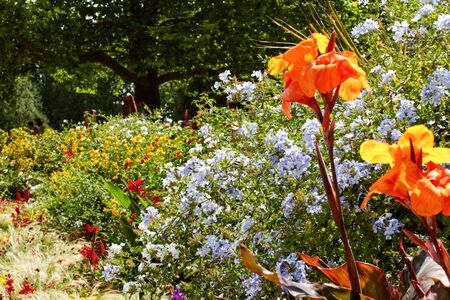Introduction to Annual Flowers in the UK
Annual flowers hold a special place in British gardening, offering not only bursts of colour but also a dynamic canvas that changes with the seasons. Unlike perennials, which return year after year, annuals complete their life cycle within a single growing season—making them ideal for gardeners seeking instant impact and versatility. In the UK, where gardens are celebrated as living works of art, annuals are a go-to choice for creating show-stopping seasonal displays. From formal beds in stately homes to cheerful window boxes on terraced houses, these plants allow gardeners to experiment with new combinations and colour schemes each year. Their ability to thrive in the unpredictable British climate, coupled with their wide range of hues and forms, has cemented annuals as a staple for anyone aiming to keep their outdoor spaces fresh, lively, and ever-evolving.
Classic British Annuals for Colour and Impact
When it comes to creating truly memorable seasonal displays in UK gardens, certain annuals have stood the test of time. British gardeners have long relied on a selection of classics that not only thrive in our temperate climate but also provide reliable bursts of colour from late spring through early autumn. Among these, sweet peas, marigolds, and cornflowers are perennial favourites for their easy cultivation, vibrant hues, and ability to lift any border or container arrangement.
Sweet Peas (Lathyrus odoratus)
Beloved for their delicate fragrance and enchanting palette, sweet peas are a staple in traditional British gardens. These climbing annuals flourish when given support, producing an abundance of blooms perfect for cutting. Sown in autumn or early spring, they reward gardeners with flowers from June onwards, making them ideal for both cottage gardens and allotments.
Marigolds (Tagetes spp.)
Marigolds are renowned not just for their bold yellows and oranges but also for their resilience. They tolerate the unpredictable British weather remarkably well and bring instant cheer to beds, borders, and pots. Their robust nature makes them a superb choice for novice gardeners seeking reliable results with minimal fuss.
Cornflowers (Centaurea cyanus)
Cornflowers offer a quintessentially British blue that is hard to rival. Traditionally found in wildflower meadows and now widely cultivated, these annuals add a touch of nostalgia to any display. Their nectar-rich blooms also attract pollinators—a boon for wildlife-friendly gardening.
Comparing Classic UK Annuals
| Flower | Main Colours | Sowing Time | Blooming Season | Key Features |
|---|---|---|---|---|
| Sweet Pea | Pinks, Purples, Whites | Autumn/Early Spring | June-September | Fragrant; Excellent Cut Flowers; Climbing Habit |
| Marigold | Yellow, Orange, Red | Spring | June-October | Drought Tolerant; Pest Deterrent; Easy to Grow |
| Cornflower | Blue, Pink, White | Spring/Autumn | June-August | Nectar-rich; Wildlife Friendly; Traditional Meadow Flower |
Why Choose These Annuals?
The enduring popularity of these varieties is rooted in their reliability and versatility across different garden styles. Whether you favour a formal bedding scheme or a more relaxed cottage look, incorporating sweet peas, marigolds, and cornflowers ensures your seasonal displays will be both vibrant and unmistakably British.

3. Choosing the Right Annuals for British Climates
When it comes to selecting annual flowers for dazzling displays in UK gardens, understanding the country’s diverse climate is crucial. The British Isles experience a mix of weather patterns, from the milder and wetter west to the often cooler and drier east. This variability means that not all annuals will perform equally well in every region, so a thoughtful approach is essential.
Consider Regional Weather Patterns
If you live in Scotland or northern England, you’ll know that summers can be short-lived and cool spells are common, even in July and August. In contrast, southern counties like Kent or Cornwall may enjoy longer growing seasons but still face unpredictable rainfall and cloudy days. Choose hardy varieties such as calendulas, cornflowers, and marigolds for cooler areas; they thrive despite lower temperatures and less sunshine.
Timing Is Everything
The UK’s tendency towards late frosts means timing your sowing is vital. For early colour, opt for cold-tolerant annuals like pansies and violas which shrug off chilly nights. If you’re keen on tender blooms such as petunias or cosmos, wait until all risk of frost has passed—usually late May in most regions—before planting out.
Soil and Shelter Considerations
British soils range from heavy clays to light sands, and drainage can vary dramatically even within a single garden. Improve clay soils with grit or compost before sowing, and consider raised beds if your plot is prone to waterlogging. Also, take advantage of sheltered spots near walls or fences to protect delicate annuals from strong winds and sudden temperature drops.
Choose Resilient Varieties
Look for cultivars described as ‘weather-resistant’ or ‘rain tolerant’—these will cope better with sudden downpours or persistent drizzle that can flatten more delicate blooms. British favourites like sweet peas, nasturtiums, and snapdragons are generally robust options that perform reliably across most regions.
By matching your plant choices to local conditions and being mindful of the UK’s famously capricious weather, you’ll set yourself up for success—and enjoy vibrant annual displays from spring right through to the first autumn chills.
4. Design Tips for Show-stopping Displays
Creating a truly memorable seasonal display with annuals is as much about design as it is about plant selection. Here are some practical tips tailored for UK gardens, blending traditional English bedding schemes with modern aesthetics to help you achieve maximum visual impact.
Classic English Bedding: Structure and Repetition
The time-honoured “carpet bedding” style favoured in historic British parks and estates relies on massing single varieties for bold colour blocks and crisp outlines. Consider planting Begonia semperflorens, Lobelia erinus, or Ageratum houstonianum in repeated swathes or geometric patterns for that classic formal look. Use low-growing annuals at the front and taller varieties like Cannas or Cosmos behind to create depth and structure.
Modern Approaches: Layered Colour and Texture
If you prefer a more contemporary effect, experiment with looser groupings and mixed textures. Combine annuals such as Rudbeckia hirta, Nicotiana alata, and Zinnia elegans for vibrant, informal displays. Pair spiky forms (e.g., Salvia splendens) with trailing types like Bacopa to add movement and contrast. Intermingle foliage-rich choices such as Coleus for extra dimension.
Colour Combinations: Harmonies and Contrasts
| Colour Scheme | Suggested Annuals | Effect |
|---|---|---|
| Pale Blues & Whites | Lobelia, Alyssum, Cosmos Purity | Classic, calming; suits cottage borders |
| Burgundy & Orange | Zinnia, French Marigold, Salvia Blaze | Vibrant, contemporary; ideal for pots |
| Pinks & Purples | Nicotiana, Petunia Tidal Wave, Verbena | Sophisticated; perfect for mixed beds |
| Lime & Crimson | Coleus Kong Rose, Begonia, Fuchsia | Dramatic contrast; great for focal points |
Pointers for Lasting Impact:
- Layer heights: Place the tallest plants centrally (for island beds) or at the back (for borders), grading down to shorter fillers and edging plants.
- Repeat key colours: Use your primary colour in multiple spots to tie the whole scheme together.
- Add evergreens: Integrate small shrubs or box balls for winter backbone once annuals fade.
- Don’t forget scent: Include fragrant options like sweet peas or night-scented stock near paths or seating areas.
A Final Word on Spacing and Succession Planting:
Crowding annuals can reduce their vigour, so follow recommended spacings to encourage bushiness and flowering. For uninterrupted displays from spring through autumn, consider planting early-flowering annuals first, then filling gaps with later performers as the season progresses. By thoughtfully combining these principles—drawing on both British tradition and fresh ideas—you can ensure your garden beds become genuine show-stoppers year after year.
5. Planting and Maintenance Essentials
If you want your annual flower displays to truly stand out in UK gardens, it pays to get the basics right from the start. Here are some practical tips tailored for British gardeners, focusing on sowing times, protecting against pests and unpredictable weather, and keeping your seasonal displays looking their best.
When to Sow for Best Results
Timing is everything in the UK’s variable climate. For most annuals, sow seeds indoors from late February to April, using seed trays or small pots on a sunny windowsill or in a greenhouse. Harden off seedlings by gradually exposing them to outdoor conditions before planting out after the last frost—usually mid to late May in much of England, but later in Scotland and colder regions. Direct sowing outdoors can often begin in late April or early May once the soil has warmed up.
Defending Against Slugs and Pests
Slugs are notorious for making short work of tender young shoots, especially after rainy spells. To defend your display:
- Use copper tape around pots or beds as a deterrent.
- Try wildlife-friendly slug pellets (iron phosphate-based), or set beer traps.
- Encourage natural predators like frogs and hedgehogs by providing suitable habitats nearby.
For aphids, a strong blast with water or introducing ladybirds can help keep populations down without resorting to harsh chemicals.
Weatherproofing Your Annuals
The British weather is famously fickle—late frosts, heavy rain, and sudden heatwaves can all take a toll. Cloches or horticultural fleece offer vital protection during cold snaps. In wet summers, good drainage is key; consider raised beds or improving soil with grit. During dry spells, water early morning or evening and mulch around plants to retain moisture.
Keeping Displays Fresh All Season
Deadheading—removing spent blooms—encourages most annuals to produce more flowers rather than setting seed. Feed your displays every couple of weeks with a balanced liquid fertiliser to maintain vigour through summer. For hanging baskets and containers, trim back straggly growth in midsummer for a flush of new blooms. Finally, stay vigilant for any signs of disease or stress so you can act quickly and keep your garden show-stopping all season long.
6. Inspiring Annual Flower Combinations
If you’re looking to elevate your garden with dazzling displays, carefully chosen annual flower combinations can make all the difference. Here are some curated examples of winning colour pairings and planting ideas, perfectly suited for beds, borders, and containers across the UK’s varied climates and styles.
Classic Cottage Charm
For a timeless British look, try mixing Cosmos ‘Purity’ with Nigella (Love-in-a-Mist) and Sweet Peas. Their soft whites, blues, and pinks mingle effortlessly, creating airy movement and gentle fragrance—ideal for informal borders or cottage-style beds.
Bold & Brilliant Contrasts
If you fancy a punchy statement in urban gardens or patio pots, combine French Marigolds, Zinnias, and Salvia ‘Blaze of Fire’. The fiery reds and oranges set against deep blue spikes guarantee a show-stopping visual impact all summer long.
Cool & Calm Containers
For a more relaxed feel, especially suitable for shaded spots or modern spaces, plant Lobelia ‘Cambridge Blue’ with trailing Bacopa and upright Ageratum. Their cool blues and whites look crisp in terracotta pots or window boxes, offering continuous blooms well into autumn.
Wildlife-Friendly Pairings
Encourage bees and butterflies by pairing Calendula ‘Indian Prince’ with striking purple Alyssum. This mix not only supports pollinators but also brings warm golds and purples to garden edges or allotment rows.
Tips for Cohesive Planting
Stick to two or three dominant colours per grouping for harmony, vary plant heights for depth, and repeat successful pairings throughout beds or containers. Whether your taste is classic or contemporary, these combinations will help you achieve lush, vibrant displays that thrive throughout the British growing season.


